
New releases
A smarter, simpler Attentive
Explore new features →
Explore new features →
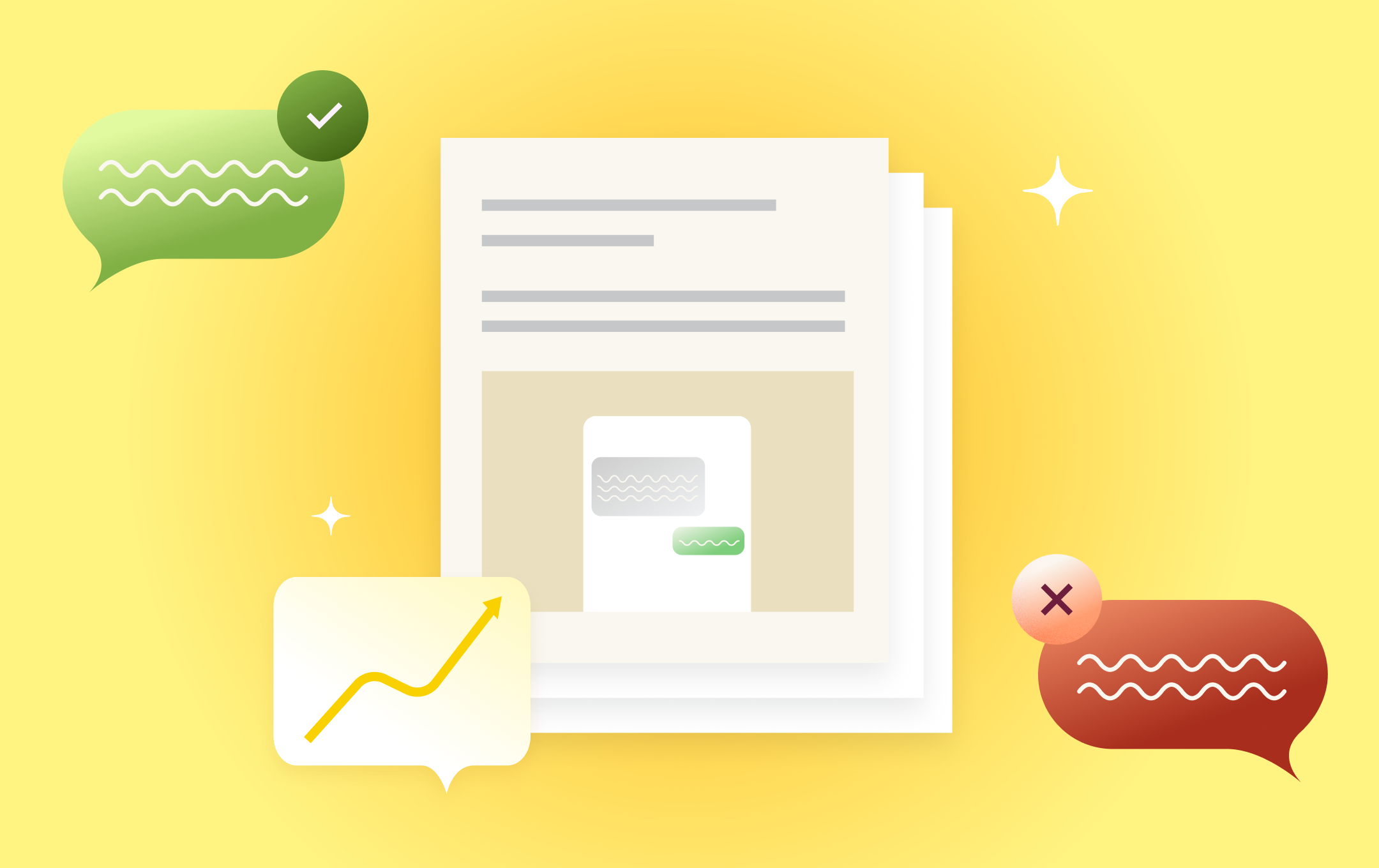
The right SMS message copy can boost conversion rates by up to 19%. The wrong copy can harm CVR by as much as 24%. But until now, no one had the data to prove which specific elements of text messages drive performance—and which ones hurt it.
We changed that by analyzing over 25 billion SMS campaign messages sent through the Attentive platform in 2024. We drew on what we’ve learned from working with thousands of marketers to build a comprehensive content framework and tag more than 100 different content components in each message. Think: scarcity language, product mentions, tone, offer formats, and dozens of other elements that marketers choose when crafting their campaigns.
Then, we built a state-of-the-art analytics engine to isolate the true impact of each individual message element. This approach moves beyond simple correlation to identify causation, controlling for confounding factors like seasonality, company baseline performance, message timing, and vertical to deliver the most accurate performance insights possible.
The result? The first-ever comprehensive analysis of what SMS content actually works today.
It's based on the results of real messages that brands sent to customers—giving you highly actionable insights you can apply to your program right away.

This is a preview of the full report which reveals even more elements that boost SMS performance—plus elements to avoid that could be harming your campaigns.
Want the complete analysis? Attentive customers can log in to view the full report. Not a customer yet? Book a demo to access these exclusive insights and join the email and SMS platform that turns data into your competitive advantage.
What you say in your SMS messages significantly impacts campaign performance. A single phrase or tone shift can mean the difference between a message that converts and one that gets ignored.
Our analysis reveals that:
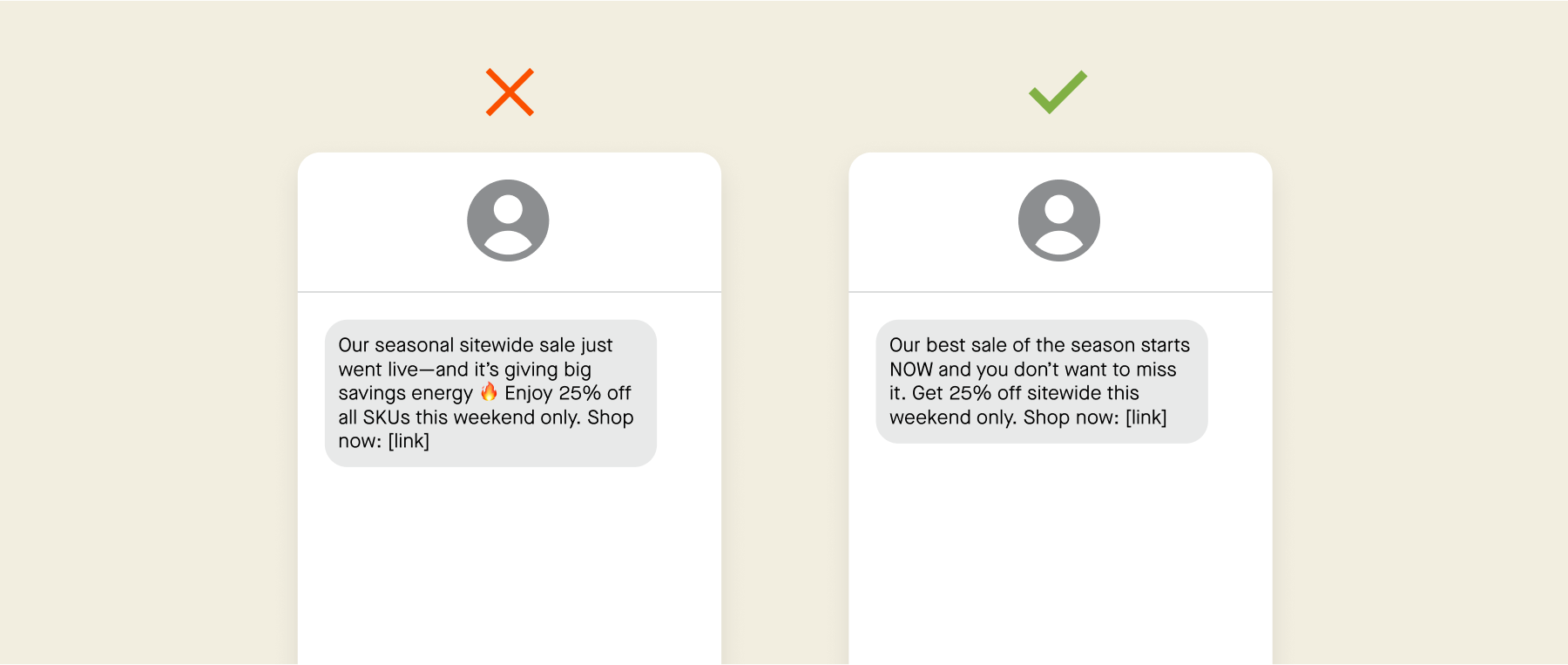
In this example, a poorly crafted SMS message uses a funny tone and jargon to promote an offer—resulting in a campaign that’s hard for the audience to connect to.
The improved version of the message uses superlative to describe the sale, second-person to make the offer feel personal, and it gets a boost from scarcity-driven language.
This research is only possible because of Attentive's unique position in the SMS marketing ecosystem. As the first-to-market SMS marketing software in 2016 and leading provider ever since, we have years of experience and the largest data set on SMS performance in the world.
This groundbreaking analysis delivers insights with:
Unprecedented scale and scope.
We analyzed a massive amount of SMS campaign data in a way that has never been done before—over 25 billion messages from thousands of brands across 13 industries. There are near infinite combinations of message content, so to narrow it down, we drew on what we’ve learned from working with thousands of marketers to build a comprehensive content framework. This allows us to then identify and tag more than 100 different message components, including complex features like tone, language styles, product mentions, and offer formats.
Advanced causal analytics.
The biggest challenge in analyzing message performance is separating correlation from causation. Confounding factors like seasonality or company baseline performance can skew results.
Our solution: We built a sophisticated analytics engine that removes bias from over 50 confounding factors to determine the true impact of each messaging feature. The engine is powered by a Propensity Score Matching (PSM) algorithm—a similar methodology used by companies like Airbnb and Netflix to determine causal effects from data. PSM works by finding “identical twins”: messages that are similar in every way except for the feature being analyzed. Any performance difference between those messages is therefore attributable to that feature.
The result: The first-ever SMS message analysis engine that gives the clearest possible view of what each element contributes to performance—giving you insights you can trust and act on.
The learning compounds as we continue developing our framework, test new strategies, and identify new content elements that lead to conversions.
When your SMS campaigns include discounts, sales, or promotional offers, subscriber expectations shift. They're primed for a deal and ready to act—but only if your message hits the right notes.
Our analysis of offer-based campaigns reveals that the most effective content elements for messages including a discount often differ from those that work in other contexts.
Top-performing message elements can boost conversion rates by up to 12% and click-through rates by 10% in offer campaigns. But choose the wrong elements, and you could see conversion rates drop by as much as 11% and click-through rates by 5%.
Context matters, too. How you combine different content elements can change the results. A feature that performs well on its own might hurt performance when paired with certain other elements—or it might create an even bigger lift when combined strategically.
These insights are based on billions of messages across over a dozen industries, giving you a data-backed roadmap for crafting offers that convert.
Scarcity and urgency language creates immediate pressure to act by highlighting limited product availability or time constraints. This includes phrases that suggest products are rare, running low, or available for a limited time—making subscribers feel they’ll miss out if they don’t act now.
The best use of scarcity creates genuine urgency through believable time or quantity constraints.

Other elements magnify the impact of scarcity language, creating a compound effect. Compared to all non-scarcity messages, these are the top-performing elements to combine with scarcity:
Scarcity isn’t universally effective. When paired with humor, this combo actually negates the impact of scarcity. Compared to non-scarcity messages, scarcity messages with a humorous tone improve conversions by a mere 0.6% and harm clicks by -0.3%.
The playful tone undermines the urgency you’re trying to create by making your scarcity claims feel less serious.
Using percentage offer formatting for deals—like “X% off—consistently outperforms dollar amounts like “$X off” when it comes to conversions.
Percentages require less mental math. When someone sees “$20 off,” they need to figure out what they’re buying to understand the actual value. “20% off” immediately communicates value that shoppers can process quickly in the moment they’re deciding whether to buy.

Even if your dollar savings are substantial, test leading with the percentage and including the dollar amount as a supporting detail: “20% off mattresses (save up to $200)”.
Speaking directly to subscribers with “you,” “your,” and “yourself” in offer messages consistently outperforms generic messaging by making offers feel personally relevant rather than broadcast to everyone—even if they are.
It shifts focus to the subscriber, making the same offer feel tailored rather than mass-distributed.
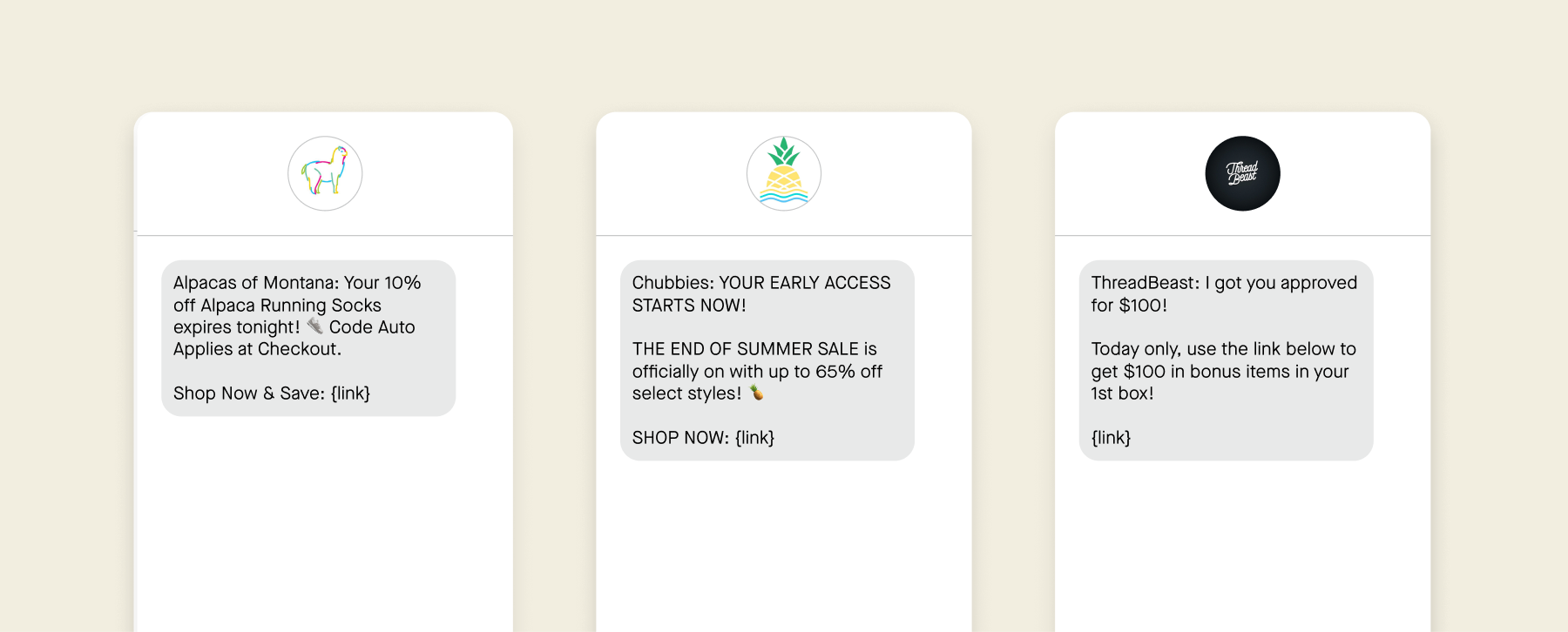
The full analysis reveals all nine high-impact campaign elements—plus the four performance-killing mistakes that could be harming your conversion rate by up to 11%.
Log in for the full report or get a demo to unlock these insights and gain access to industry-leading email and SMS marketing tools.
Without the immediate hook of a discount or sale, SMS campaigns without an offer need to work differently to capture attention and create a desire to buy.
Subscribers are evaluating your messages differently based on desirability, timing, and needs rather than deals.
Top-performing SMS message elements can boost conversion rates by up to 19% and click-through rates by up to 9% in messages without offers.
But the wrong ones can cause conversion rates to drop by as much as 11% and click-through rates by 8%.
Combining features here also has an impact—sometimes in different ways compared to messages with offers.
Here’s what data from 25 billion campaign sends across 13 industries has to say about crafting high-performing messages without discounts.
Stock messaging is a powerful motivator to act, no discount required. Mentioning that inventory is limited or a product could sell out is the most effective way to drive purchases in messages that don’t contain an offer.
If you can, use real-time inventory levels to send these messages to subscribers who have shown interest in a product, or to shopper segments likely to be interested based on interests and purchase behavior.
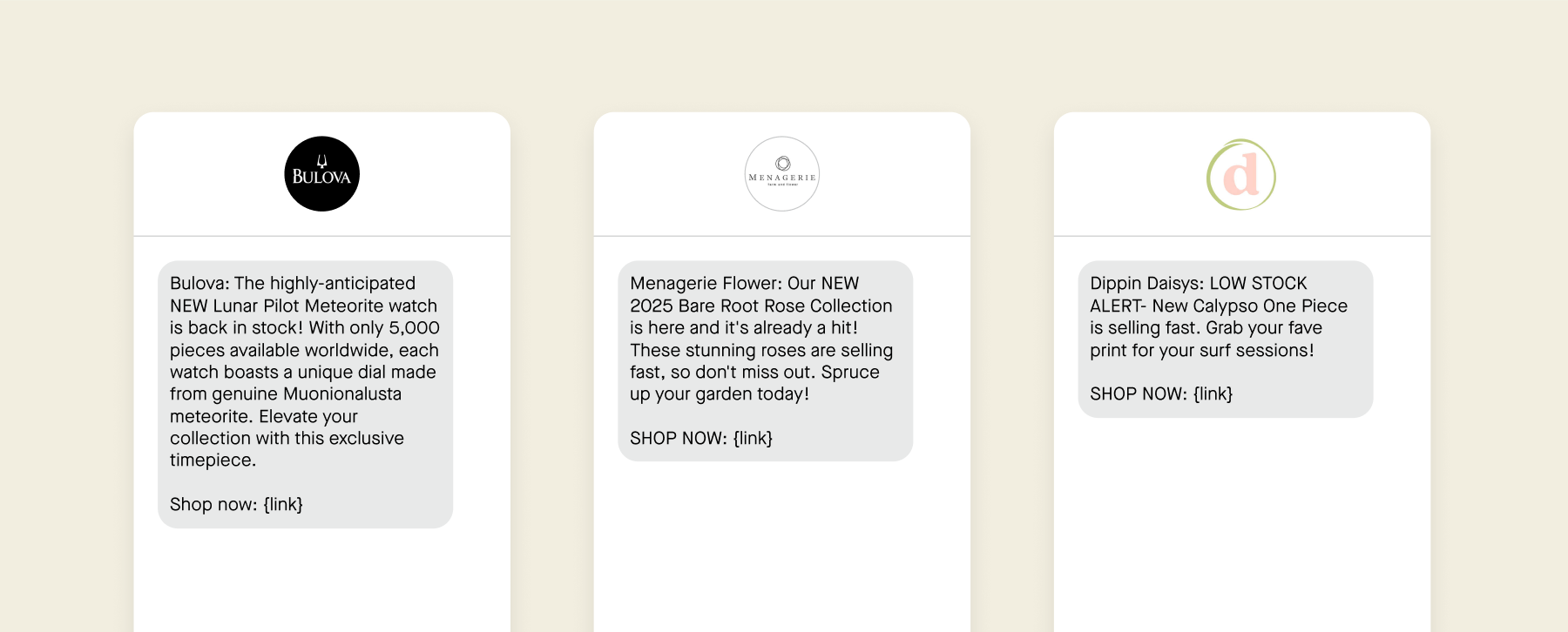
New product mentions also perform exceptionally well in campaigns without an offer. Product launches leverage curiosity and natural urgency to get the latest products and styles.
When subscribers are excited for something new, it justifies action even at full price.
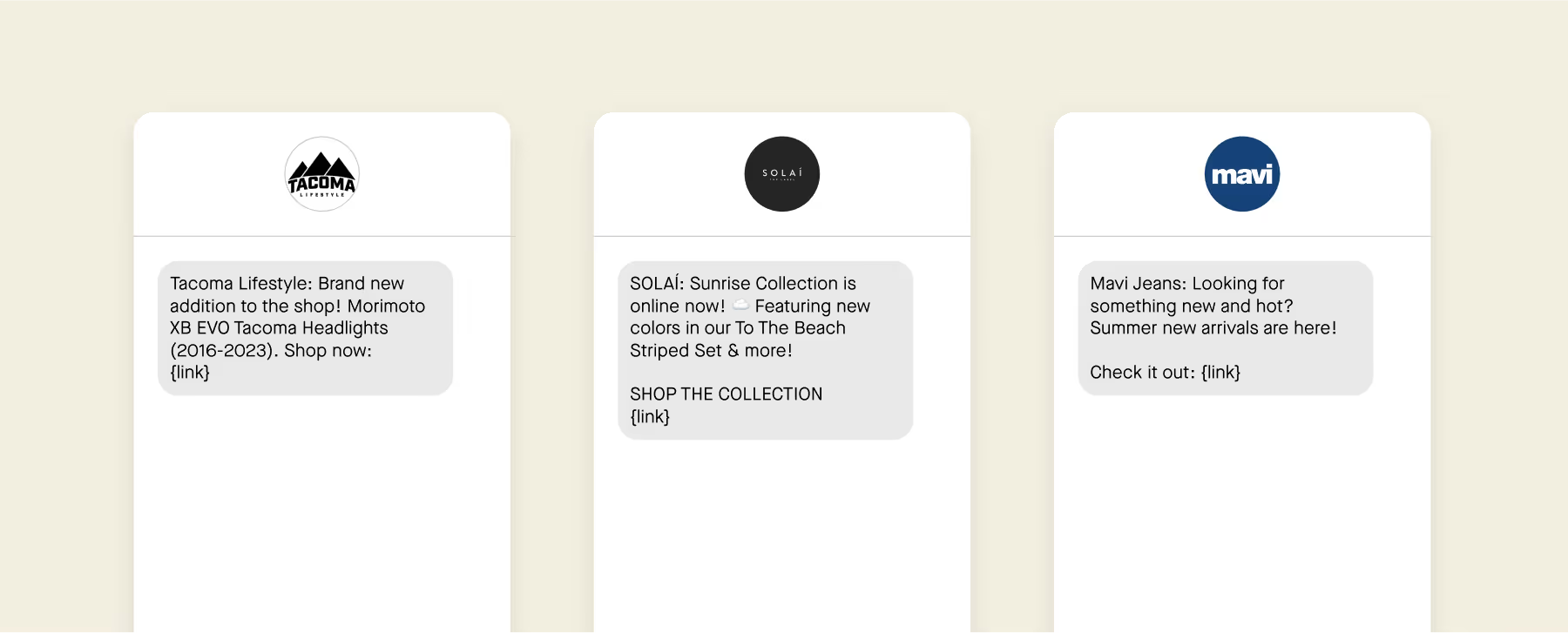
New variants of tried-and-true products can trigger the same response, so these SKUs are also worthy of an announcement.
Loss aversion is a strong motivator. Using language that focuses on what customers might miss out on creates emphasis around problems your product solves or opportunities that won’t last.
Highlight what could happen if customers don’t act. The key is to make the consequence feel real and immediate.
This is a great approach for limited launches, price increases, and communicating product benefits.
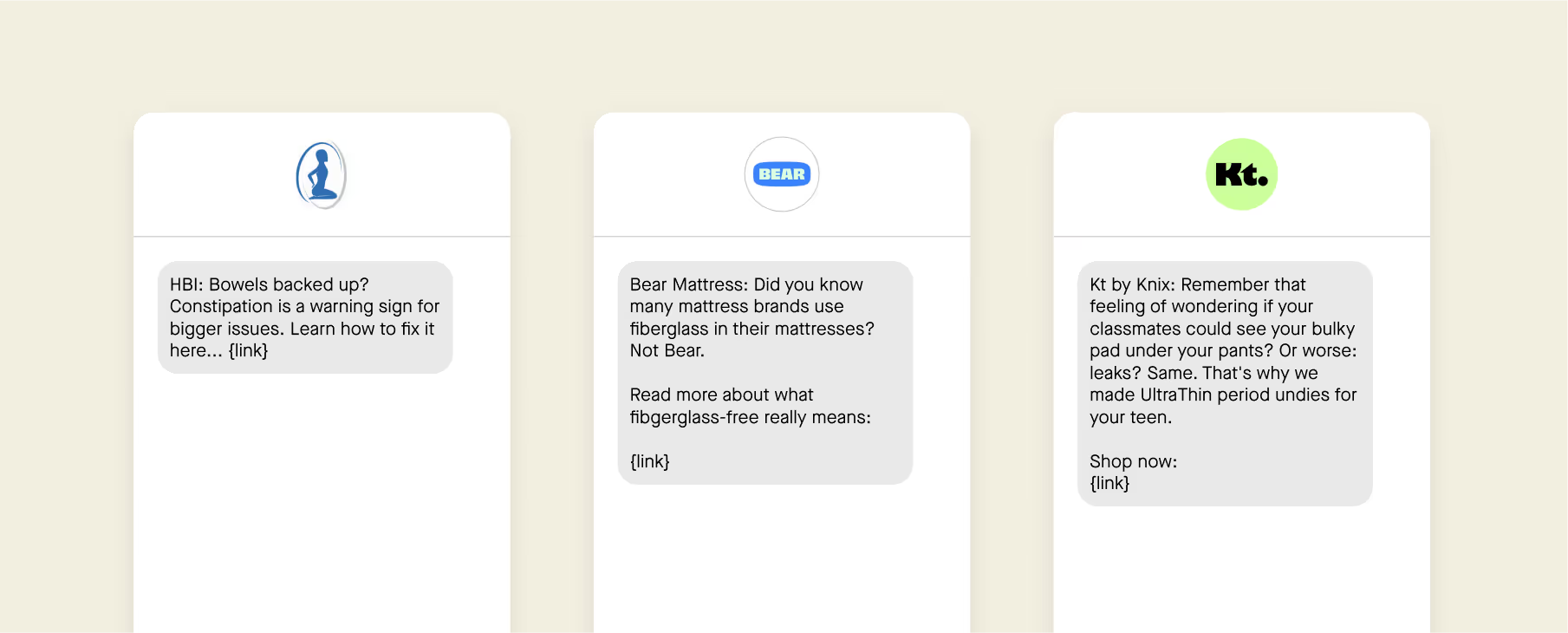
This is just the beginning. The complete analysis reveals all 6 proven elements that boost non-offer campaigns, plus the 2 critical mistakes that can tank your results by double digits.
This is the most comprehensive analysis of SMS content performance ever conducted—insights that no other platform could deliver because they don’t have the scale or depth of message data that Attentive does.
But this data is only valuable when you put it to work. Now it’s your turn to transform these insights into higher-performing campaigns:
When every text message competes for attention, small improvements can create big performance wins.
This preview gives you a strong starting point, but only scratches the surface of what analyzing 25 billion SMS messages revealed about content performance.
Want access to all the insights? Log in to access the complete report or book a demo to discover how Attentive can transform email and SMS marketing into one of your highest-performing revenue channels.